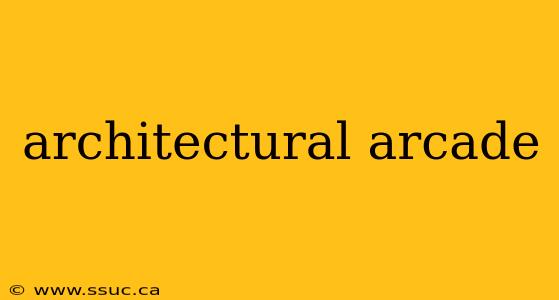Meta Description: Discover the captivating world of architectural arcades! This comprehensive guide explores their history, design elements, notable examples, and enduring appeal in modern architecture. Learn about different arcade types, construction techniques, and their role in urban design. Delve into the fascinating evolution of arcades from ancient Roman structures to contemporary designs, showcasing their versatility and timeless elegance.
A Journey Through Time: The History of Architectural Arcades
Architectural arcades, those elegant rows of arches supported by columns or piers, are a timeless feature in architecture. Their history is rich and varied, spanning millennia and diverse cultures. Early examples can be traced back to ancient Rome, where they served both practical and aesthetic purposes. Roman arcades provided covered walkways, protecting citizens from the elements while simultaneously creating impressive public spaces. The Colosseum, with its tiered arcades, stands as a testament to this early mastery.
From Roman Roots to Medieval Marvels
The use of arcades continued through the medieval period, evolving into sophisticated designs. Medieval arcades often incorporated intricate stonework, reflecting the stylistic preferences of the era. Think of the beautiful arcades found in Italian piazzas or the cloisters of monasteries. These spaces provided not only shelter but also social hubs and gathering places.
Renaissance Revival and Beyond
The Renaissance saw a renewed interest in classical forms, leading to a resurgence in the popularity of arcades. Renaissance arcades often featured graceful arches and decorative detailing, enhancing the grandeur of palaces and public buildings. This trend continued through later architectural movements, with variations appearing in Baroque, Neoclassical, and even modern designs.
Design Elements of Architectural Arcades
The design of an arcade is more nuanced than simply a series of arches. Several key elements contribute to its overall aesthetic and functionality:
1. Arch Type: Defining the Style
The type of arch used significantly impacts the arcade's appearance. Common arch types include:
- Round arches: Classic and elegant, echoing Roman designs.
- Pointed arches: Characteristic of Gothic architecture, creating a sense of upward movement.
- Horseshoe arches: Found in Moorish architecture, exhibiting a unique curved shape.
- Tudor arches: Four-centered arches common in Tudor-style buildings, characterized by a flattened curve.
2. Column and Pier Support: Structural Elegance
Arcades are supported by columns or piers, which are equally significant design elements. The style, spacing, and materials of these supports influence the overall aesthetic and structural integrity of the arcade. Consider the difference between slender, delicate columns and robust, imposing piers.
3. Vaulting and Roofing: Creating Covered Spaces
The roofing or vaulting above the arcade completes the structure and creates the covered space. The choice of roofing material and construction method affects the atmosphere and functionality of the arcade. A simple flat roof might be functional, but a vaulted ceiling adds a layer of architectural sophistication.
4. Materials and Finishes: Reflecting Context and Style
The materials used to construct an arcade greatly influence its appearance and durability. Stone, brick, concrete, and even metal have all been employed, often reflecting the available resources and the prevailing architectural style. The finish—whether it's smooth, textured, or adorned with ornamentation—further enhances the aesthetic impact.
Notable Examples of Architectural Arcades Around the World
Numerous stunning examples of arcades exist globally, each showcasing unique design features and historical context:
- The Royal Arcade, London: A beautiful Victorian-era shopping arcade known for its elegant cast-iron structure.
- The Galleria Vittorio Emanuele II, Milan: A masterpiece of 19th-century Italian architecture, featuring stunning glass vaulted ceilings.
- The arcade of the Doge's Palace, Venice: A breathtaking example of Venetian Gothic architecture, showcasing intricate stonework and arches.
- The arcades of Piazza del Campo, Siena: A charming example of medieval Italian architecture, creating a lively public space.
Architectural Arcades in Modern Design
Despite their historical roots, arcades continue to find their place in contemporary architecture. Modern arcades often incorporate innovative materials and construction techniques while retaining the fundamental principles of covered walkways and aesthetically pleasing spaces. They serve as transitional elements, connecting buildings or creating sheltered pathways within urban environments.
The Enduring Appeal of Architectural Arcades
The enduring appeal of architectural arcades lies in their ability to seamlessly blend functionality and aesthetics. They offer sheltered walkways, enhance the visual appeal of buildings and urban spaces, and create inviting gathering places. Whether found in historical city centers or modern developments, arcades continue to enrich our built environment. Their timeless elegance and versatility ensures that they will remain a captivating element in architecture for generations to come.
